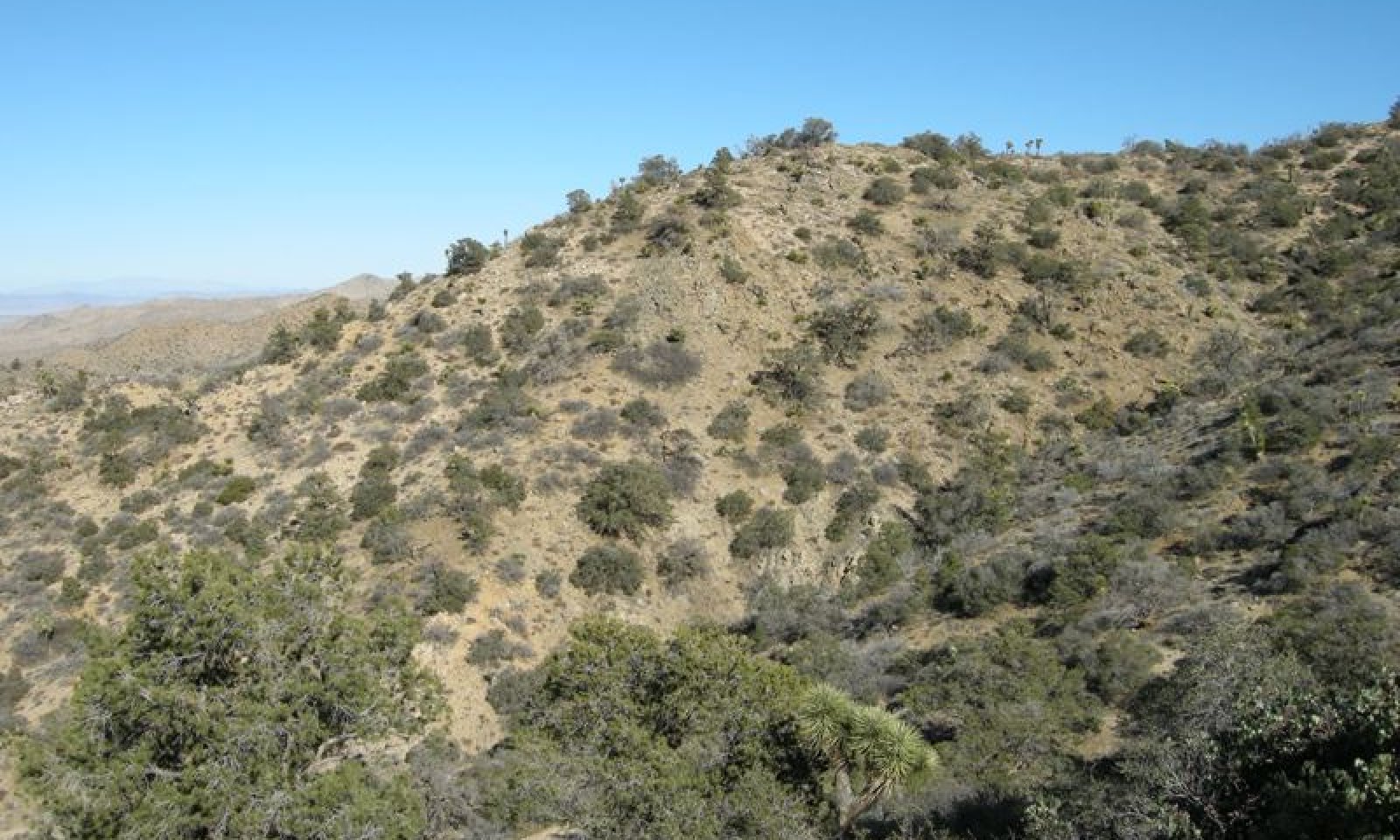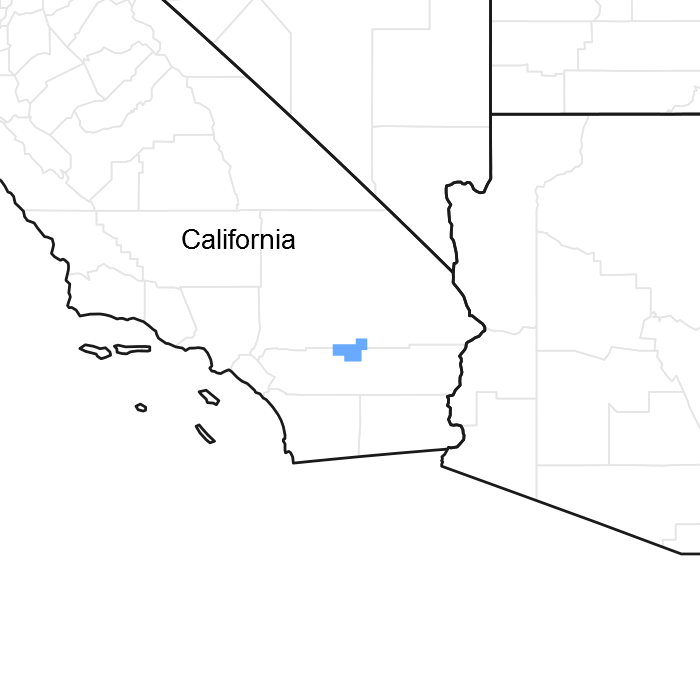

Natural Resources
Conservation Service
Ecological site R030XE196CA
Sandy Xeric-Intergrade Slopes
Last updated: 10/21/2024
Accessed: 12/21/2025
General information
Provisional. A provisional ecological site description has undergone quality control and quality assurance review. It contains a working state and transition model and enough information to identify the ecological site.

Figure 1. Mapped extent
Areas shown in blue indicate the maximum mapped extent of this ecological site. Other ecological sites likely occur within the highlighted areas. It is also possible for this ecological site to occur outside of highlighted areas if detailed soil survey has not been completed or recently updated.
MLRA notes
Major Land Resource Area (MLRA): 030X–Mojave Basin and Range
MLRA Description:
Major Land Resource Area (MLRA) 30, Mojave Desert, is found in southern California, southern Nevada, the extreme southwest corner of Utah and northwestern Arizona within the Basin and Range Province of the Intermontane Plateaus. The climate of the area is hot (primarily hyperthermic and thermic; however at higher elevations, generally above 5000 feet, mesic, cryic and frigid) and dry (aridic). Elevations range from below sea level to over 12,000 feet in the higher mountain areas found within the MLRA. Due to the extreme elevational range found within this MLRA, Land Resource Units (LRUs) were designated to group the MLRA into similar land units.
LRU notes
This LRU (designated by ’XE’) is found only in California at the transition zone between MLRA 20, the Southern California Mountains, and MLRA 30. Elevations range from 3500 to 5800 feet and precipitation ranges from 8 to 12 inches per year. The LRU is characterized primarily by cool thermic and mesic soil temperature regimes and aridic bordering on xeric soil moisture regimes. Precipitation is mostly winter, receiving approximately 85% between October and February, going from rain in the fall to snow into the winter. Snow can range from between 1 and 6 inches. Soils show indications of greater moisture storage with some mollic colors in the soil profile. Vegetation is highly productive and vigorous for the Mojave Desert and includes non-typical Mojave species such as, scrub oaks, manzanita, sumac, ziziphus, mountain mahogany, presence of singleleaf pinyon, and desert needlegrass.
Ecological site concept
This site occurs on steep mountain slopes between 3400 to 5600 feet in elevation. Soils are typically shallow with an aridic bordering on xeric soil moisture regime and a cool thermic soil temperature regime. Surface boulders and outcrops are typical. Large rock fragments make a significant contribution to the soil surface (RV > 5%). Boulders and large rock fragments contribute to soil stability and provide additional surface run-on, increasing moisture availability on the site, which supports a relatively high cover and high diversity of shrub and tree species.
Single-leaf pinyon pine (Pinus monophylla) and Muller oak (Quercus cornelius-mulleri) dominate. Important secondary species include California juniper (Juniperus californica), bigberry manzanita (Arctostaphylos glauca), blackbrush (Coleogyne ramosissima), and desert needlegrass (Achnatherum speciosum). Production reference value (RV) for is 590 pounds per acre and ranges from 230 to 950 pounds per acre depending on annual precipitation and annual species production.
Data ranges in the physiographic data, climate data and soil data are based on major components only (15 percent or greater). Information for associated minor components may be included in the narrative section.
This is a group concept and provisional STM that also covers R030XE191CA
Associated sites
| R030XB164CA |
Steep South Slopes This site occurs on steep south-facing slopes at elevations of 2300 to 3950 feet. Soils are shallow sands. The southerly aspect, hot temperatures and shallow rocky soils favor brittlebush (Encelia farinosa). Warm thermic soil temperature and aridic soil moisture regimes distinguish this site from R030XE196CA. |
|---|---|
| R030XB170CA |
Bouldery Very Shallow To Shallow Gravelly Slopes This site is found cool hills and mountains with very shallow to shallow soils over bedrock. Blackbrush (Coleogyne ramosissima), singleleaf pinyon (Pinus monophylla) and Muller oak (Quercus cornelius-mulleri) are the dominant species at this site. A typic-aridic soil moisture regime which is not borderline xeric distinguishes R030XB170CA from R030XE196CA. |
| R030XB172CA |
Warm Gravelly Shallow Hills This site is found on steep stony mountain and hill slopes with shallow to moderately deep soils. Slopes are generally greater than 40% with more than 10% surface stone cover. Creosote bush (Larrea tridentata) and Parish’s goldeneye (Viguiera parishii) dominate the site. A warm thermic temperature regime and a typic-aridic soil moisture distinguish this site from R030XE196CA. |
| R030XB189CA |
Shallow Cool Hills This site also occurs on steep mountain slopes on shallow soils with a cool thermic soil temperature regime. Blackbrush (Coleogyne ramosissima) and California juniper (Juniperus californica) are dominants at this site. R030XB189CA is distinguished from R030XE196CA by a typic-aridic soil moisture regime. |
| R030XD040CA |
Hyperthermic Steep North Slopes Hyperthermic steep north slopes with burrobush (Ambrosia dumosa) and brittlebush (Encelia farinosa) distinguish this site from R030XE196CA. |
| R030XY202CA |
Very Rarely To Rarely Flooded Thermic Ephemeral Stream This is a very rarely to rarely flooded ephemeral stream with Nevada jointfir (Ephedra nevadensis), water jacket (Lycium andersonii) and desert almond (Prunus fasciculata). |
| R030XB193CA |
Very Shallow To Moderately Deep Gravelly Slopes This site occurs on warm thermic steep hill and mountain slopes with very shallow to moderately deep soils which typically have an argillic horizon within 2 to 7 cm of the soil surface. The site is characterized by a diverse shrub assemblage, comprised of Jojoba (Simmondsia chinensis), burrobush (Ambrosia dumosa), Parish’s goldeneye (Viguiera parishii), Nevada jointfir (Ephedra nevadensis), and water jacket (Lycium andersonii), and is not strongly dominated by any one species. A warm thermic soil temperature regime and typic-aridic moisture regime distinguishes this site from R030XE196CA. |
| R030XB213CA |
Moderately Deep Gravelly Mountain Slopes This site is found on very steep, very shallow to moderately deep, warm thermic hill and mountain slopes. California juniper (Juniperus californica) and Eastern Mojave buckwheat (Eriogonum fasciculatum) are the dominant species. A warm thermic soil temperature regime and typic-aridic moisture regime distinguishes this site from R030XE196CA. |
| R030XE191CA |
Dry Sandy Mountain Slopes This site is found on steep hill and mountain slopes (30-60%). Soils are shallow to weathered bedrock. Muller oak (Quercus cornelius-mulleri) and singleleaf pinyon (Pinus monophylla) are the dominant species on R030XE191CA. A lower large fragment cover distinguishes this site from R030XE196CA. |
| R030XE200CA |
Xeric Very Deep Sandy Fan Aprons On Pediments This site occurs on hills with 4-8% slopes. Lower slopes distinguish this site from R030XE196CA. Soils are very deep to weathered bedrock, having a cool thermic temperature regime, a xeric-aridic soil moisture regime and have a sand texture. |
Similar sites
| R030XE200CA |
Xeric Very Deep Sandy Fan Aprons On Pediments This site occurs on hills with 4-8% slopes. Lower slopes distinguish this site from R030XE196CA. Soils are very deep to weathered bedrock, having a cool thermic temperature regime, a xeric-aridic soil moisture regime and have a sand texture. |
|---|---|
| R030XB170CA |
Bouldery Very Shallow To Shallow Gravelly Slopes This site is found cool hills and mountains with very shallow to shallow soils over bedrock. Blackbrush (Coleogyne ramosissima), singleleaf pinyon (Pinus monophylla) and Muller oak (Quercus cornelius-mulleri) are the dominant species at this site. A typic-aridic soil moisture regime which is not borderline xeric distinguishes R030XB170CA from R030XE196CA. |
| R030XB172CA |
Warm Gravelly Shallow Hills This site is found on steep stony mountain and hill slopes with shallow to moderately deep soils. Slopes are generally greater than 40% with more than 10% surface stone cover. Creosote bush (Larrea tridentata) and Parish’s goldeneye (Viguiera parishii) dominate the site. A warm thermic temperature regime and a typic-aridic soil moisture distinguish this site from R030XE196CA. |
| R030XE191CA |
Dry Sandy Mountain Slopes This site is found on steep hill and mountain slopes (30-60%). Soils are shallow to weathered bedrock. Muller oak (Quercus cornelius-mulleri) and singleleaf pinyon (Pinus monophylla) are the dominant species on R030XE191CA. A lower large fragment cover distinguishes this site from R030XE196CA. |
| R030XB164CA |
Steep South Slopes This site occurs on steep south-facing slopes at elevations of 2300 to 3950 feet. Soils are shallow sands. The southerly aspect, hot temperatures and shallow rocky soils favor brittlebush (Encelia farinosa). Warm thermic soil temperature and aridic soil moisture regimes distinguish this site from R030XE196CA. |
Table 1. Dominant plant species
| Tree |
(1) Pinus monophylla |
|---|---|
| Shrub |
(1) Quercus cornelius-mulleri |
| Herbaceous |
Not specified |
Click on box and path labels to scroll to the respective text.



